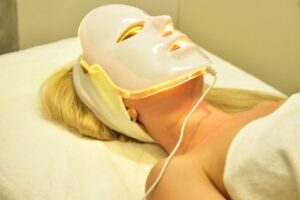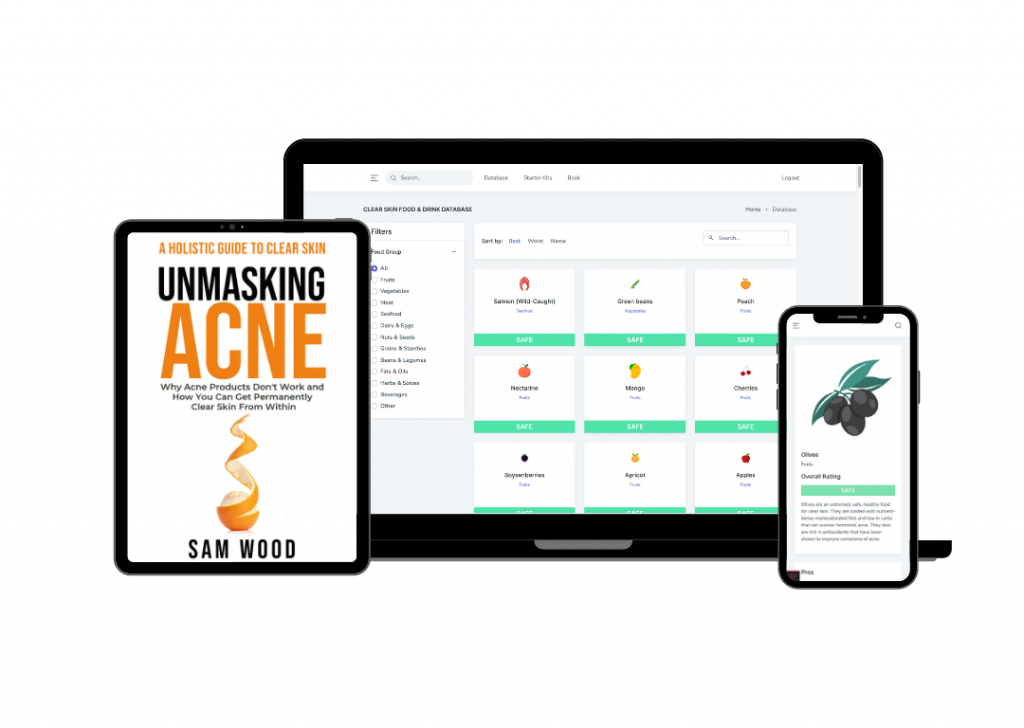Light therapy is a non-invasive treatment that kills acne-causing bacteria on the skin. This might be the answer to your acne that does not respond to every other solution you’ve tried.
Nearly 50 million people in the US suffer from acne. However, many are unhappy despite receiving treatment. Sometimes, there are undesirable and intolerable side effects from medications.
For the past 20 years, dermatologists have used light therapy, also called phototherapy, to combat acne. There are now enough studies to convince us that using visible light devices is an effective treatment. Not only is it safe, but also relatively free from side effects.
Do You Need Phototherapy for Acne?
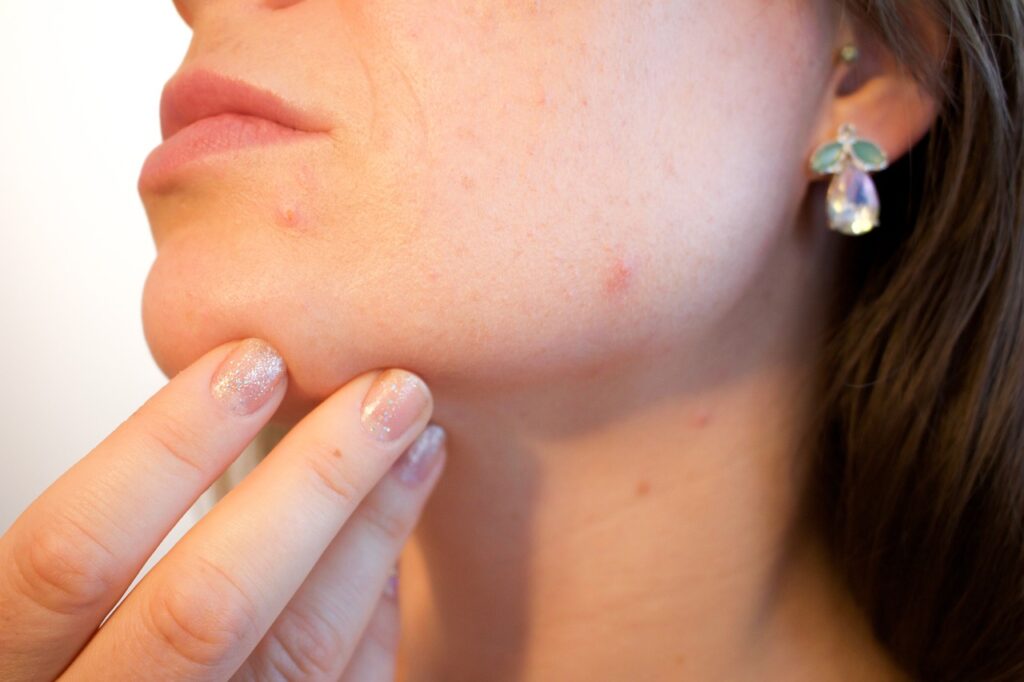
Millions of pores cover your skin and sit at hair follicles. The pores connect your skin’s surface to an underlying sebaceous gland, which produces an oily substance known as sebum. As it is constantly released, sebum can get mixed with dead skin cells and go to the surface of the pores. Excess sebum, dead skin cells, and bacteria can block the pores, causing pimples.
Several things can also lead to acne or make it worse, such as:
- Fluctuating hormones around the time of a woman’s period
- Diet, which you can easily modify
- Clothing and headgear such as hats or sports helmets
- High humidity and air pollution
- Using oily or greasy personal products, such as heavy creams, lotions, or hair pomades and oils
- Stress or increased cortisol level
- Certain medications
- Genetics
What is Phototherapy?
Phototherapy is a process that uses a specific type of light to kill acne-causing bacteria and make your skin less oily. It is remarkably effective in treating blemishes unresponsive to other treatments.
Doctors once used UV radiation from the sun to treat acne. However, while it can clear up acne, it can also cause skin cancer.
Today, they use specific wavelengths of visible light for various skin conditions without causing harm. “Visible” light means seeing the color emitted—red or blue.
When is It Used for Acne?
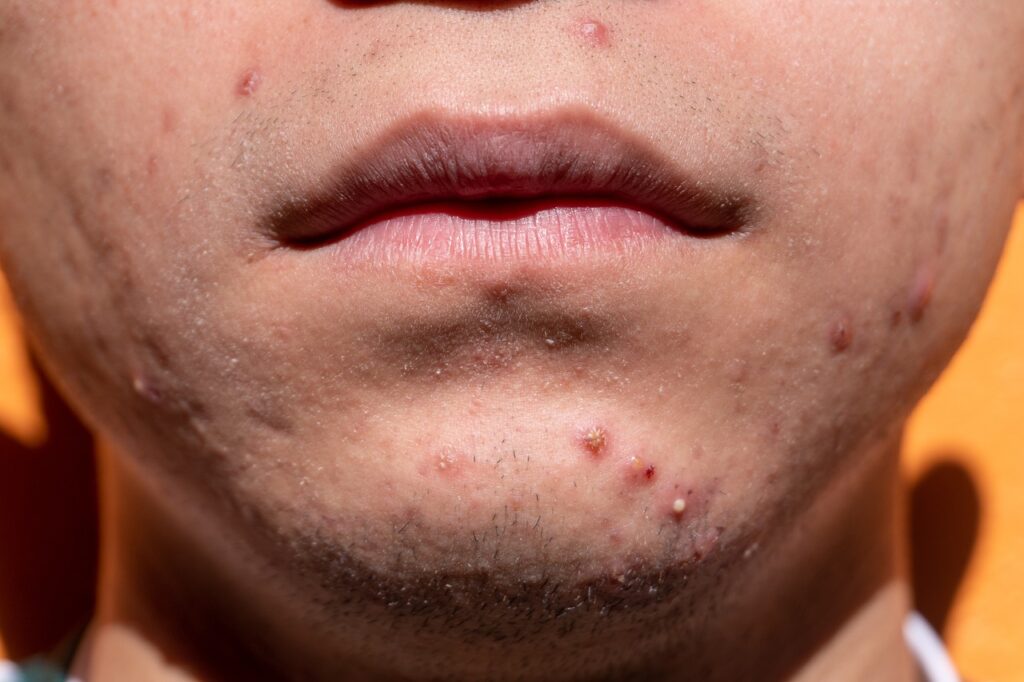
Phototherapy is a last resort kind of treatment. Even so, it may not be for those who are:
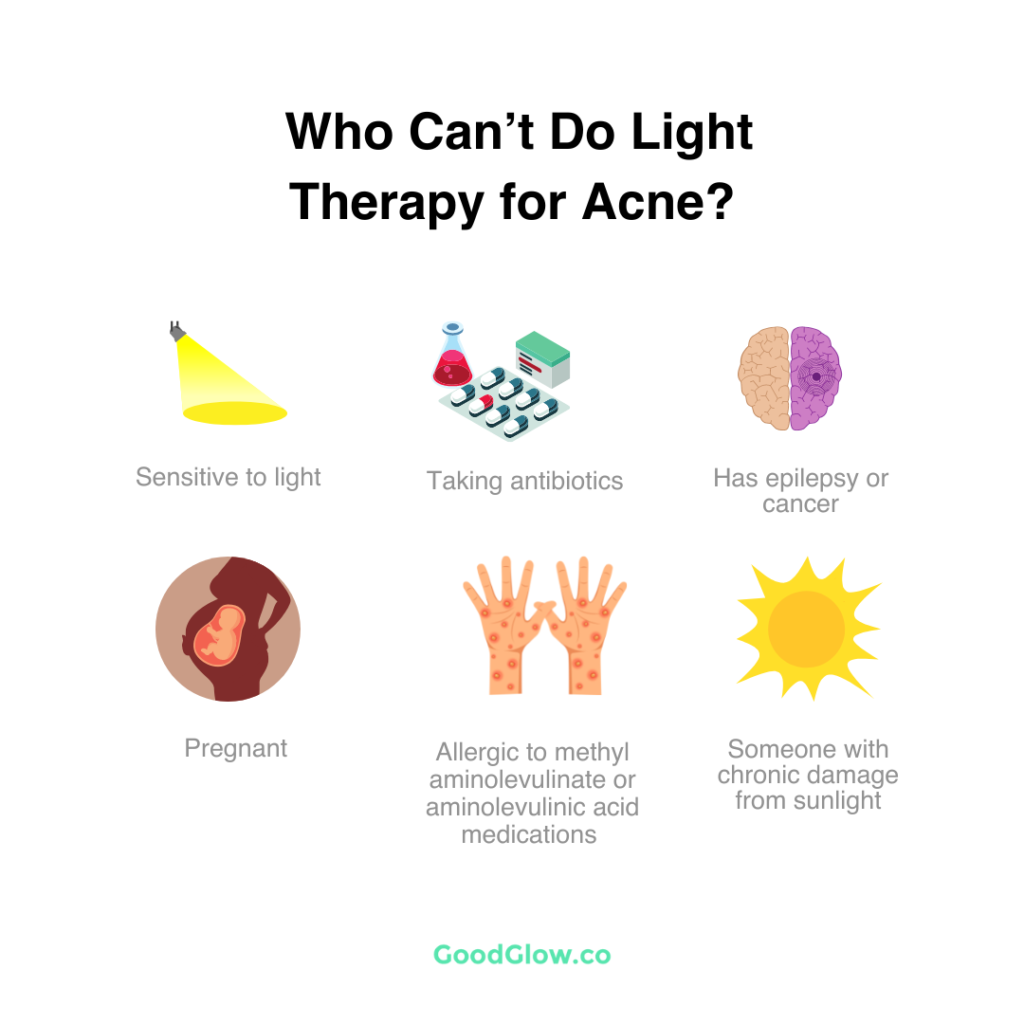
How Does Light Therapy Work?
Light therapy uses light-emitting diodes (LED). Though present since the 1960s, they have only been used for skin problems recently.
Different wavelengths of LED lights penetrate the skin at different depths. This triggers healing processes and rejuvenation in our skin.
Currently, its ability to increase collagen production makes phototherapy a popular option. This can smoothen your skin, reduce wrinkles and age spots, and help prevent other skin problems.
The Spectrum of LED Lights
Blue Light Therapy
Blue light is the best option for acne treatment. One study found that people suffering from acne treated with blue light therapy devices for five weeks saw a 77 percent improvement in their disease.
It has three distinct properties that make it an effective anti-acne weapon: antibacterial, anti-inflammatory, and reduces excess sebum.
Blue light therapy eliminates free radicals that damage and age your skin. In fact, when combined with a compound called aminolevulinic acid (ALA), it may reduce your risk of getting skin cancer.
Red Light Therapy
Red light therapy is not antibacterial but also has anti-inflammatory benefits. It promotes healing, repairs damaged tissue, and reduces the visibility of scars.
It is the best for conditions like actinic keratosis, which develops from prolonged sun exposure. But you may consider red light therapy if your acne is due to a chronic disease.
How are Light Therapy Treatments Done?
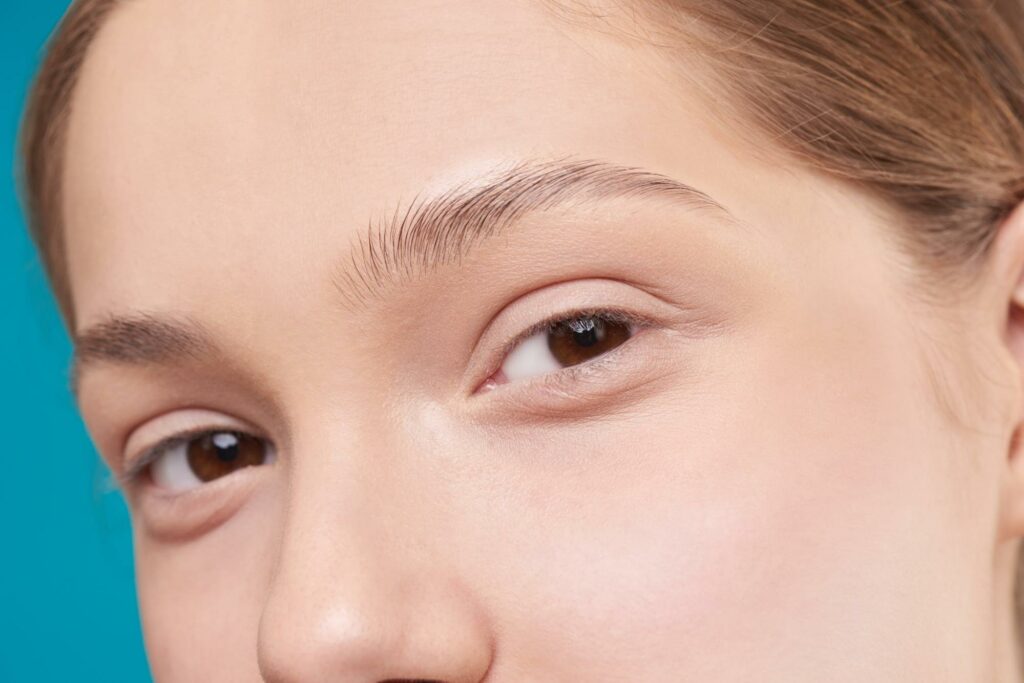
LED light therapy may be done at home or in a professional’s workplace. Pulses of light therapy will be applied to various parts of your face in a circular fashion. Each session may last 15-30 minutes and is generally not painful.
Devices in clinics can deliver more intense pulsed light than at-home devices. This makes professional treatment more efficient.
How Much Do LED Light Home Treatments Cost?
LED light home kits can cost $25 to $250 or more. Neutrogena costs around $38. Other brands like Tria, Foreo, and LightStim are available at $149 to $169.
How Often Do You Need to Use it to See Results?
Different types of light treatment and laser therapy may significantly reduce the number and severity of facial acne.
LED Light Devices
You would need several sessions of phototherapy over four to six weeks to treat mild-to-moderate acne outbreaks.
The US Food and Drug Administration (FDA) has approved some home-based LED devices. Because of the limited strength, it may be necessary to use the device twice daily, for 30-60 minutes, for up to five weeks.
Photodynamic Therapy (PDT)
PDT is ideal for severe acne. Dermatologists have helped the skin of patients with severe acne improve over a few years.
This involves a solution that makes the skin more sensitive to light. The solution is left on the skin for between 15 minutes and 3 hours per session. The dermatologist then applies light or laser on those areas.
PDT may be done over months with each session held 3-4 weeks apart. You may see results weeks after the last treatment.
What to Expect with Light Therapy?
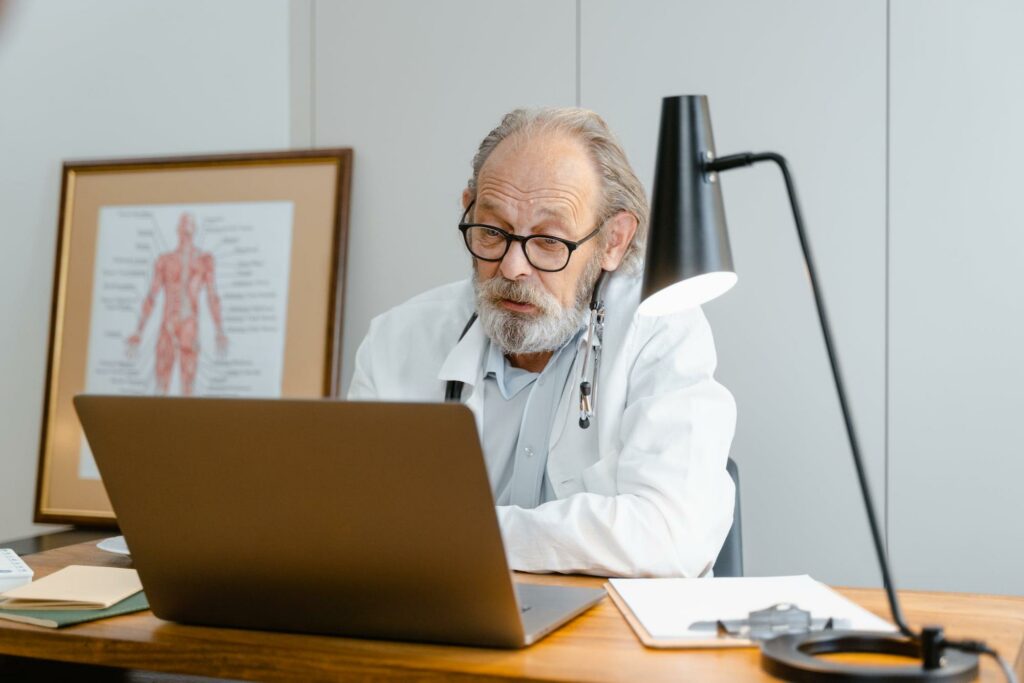
While LED devices are now considered the most effective and safest way to treat skin inflammation, such as whiteheads and blackheads, everyone will react differently.
With red light, your skin will be tighter. The anti-inflammatory properties will help prevent chronic acne and photodamage. This is helpful for skin conditions, including actinic keratosis.
With blue light, your skin will be radiant. There will be fewer bacteria and less grime that can clog your pores.
Despite these benefits, it is best to consult your dermatologist before you try this treatment. Natural treatments are available if LED light therapy is not appropriate for you. Learn more about clinically proven supplements in this eBook.
Known Side-Effects of Light Therapy
Light therapy is generally considered safe, but there can be side effects.
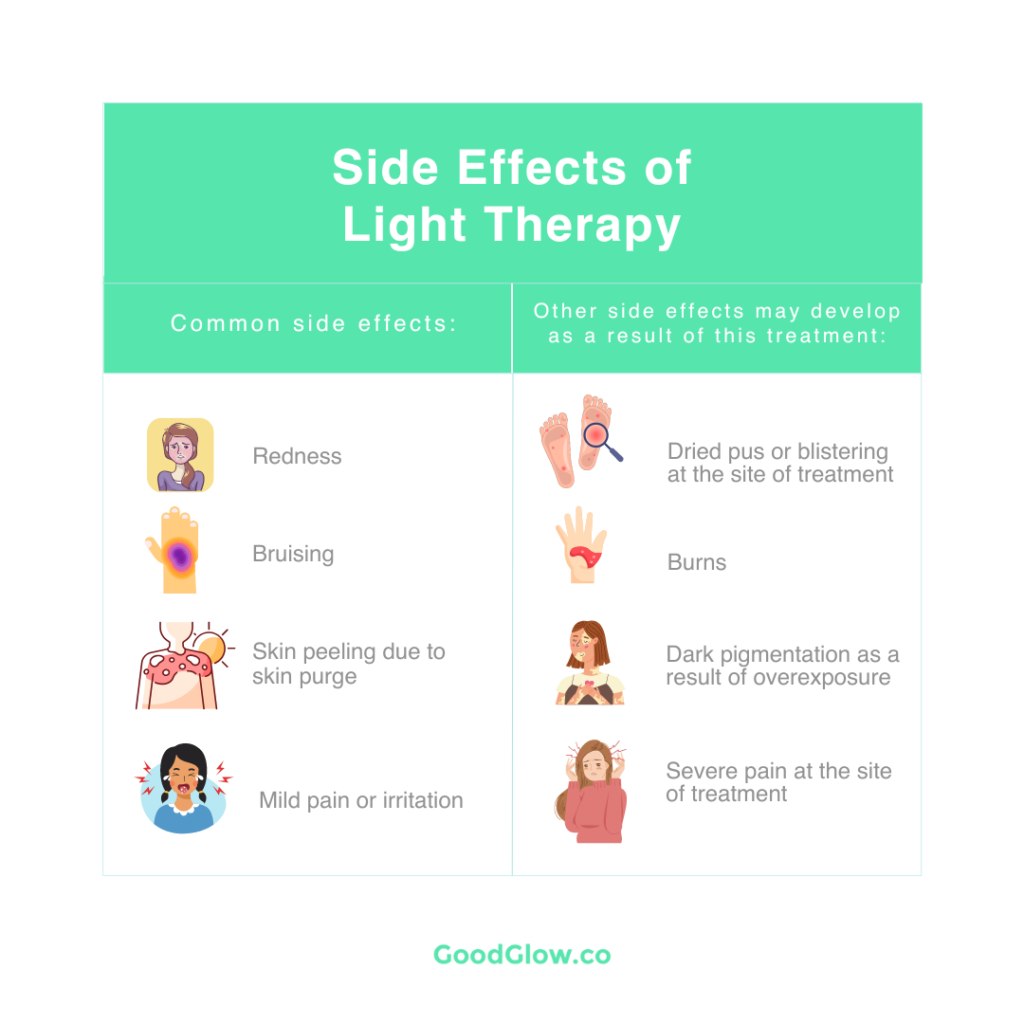
However, if your symptoms persist or you notice hives or inflammation after LED light therapy, consult your doctor immediately.
Does Light Therapy Cause Purging?
Skin purging refers to a reaction when an active ingredient increases the skin cell turnover rate.
Red LED light therapy on the face triggers cellular processes that promote cell turnover, causing mild skin purging.
Conclusion
Light therapy significantly helps with skin improvement. The most popular benefits are related to dealing with acne, wrinkles, fine lines, and other skin conditions. In addition, you may enjoy a relaxing and pampering treatment at home.
Whether you choose self-treatment at home or undergo sessions at a clinic, always include preventive measures in your routine. Consuming vegetables and fruits regularly and using natural remedies will pave the way to getting clearer skin. In fact, it might enhance the benefits of undergoing phototherapy.
After treatment, your skin may become more sensitive. Therefore, you might have to stop using exfoliants and scrubs for a few days. Remember to apply sunscreen during the daytime!
Partner light therapy with a healthy lifestyle and a good skincare routine for the best results. If you are overwhelmed with where to start, check out this informative eBook.
FAQs
Professionals may prefer blue light for acne breakouts. It is more effective against acne caused by bacteria. However, red light is suitable for rejuvenating your damaged skin.
Most people with acne will see improvements in four to six weeks of regular sessions.
Yes, some devices are FDA-approved to treat breakouts. You may use them for 30-60 minutes twice daily for up to five weeks. However, the results of self-treatment may differ from what can be achieved when you go to a clinic.
Yes. Both blue and red light therapies are safe, drug-free, FDA-approved alternatives for managing acne vulgaris.
DeMarkQ POP LED Light Zone Acne Treatment is one of the most popular light therapy devices for home use. It uses medical-grade LED lights, both blue and red, to reduce the appearance and severity of acne.
Neutrogena Light Therapy Acne Treatment is a more affordable option.
LED light therapy is only effective for inflammatory acne with red bumps or pustules. It does not treat cystic or hormonal acne.
Sources:
- “Skin Conditions by the Numbers.” American Academy of Dermatology, https://www.aad.org/media/stats-numbers
- J;, Elman M;Lebzelter. “Light Therapy in the Treatment of Acne Vulgaris.” Dermatologic Surgery : Official Publication for American Society for Dermatologic Surgery [Et Al.], U.S. National Library of Medicine, https://pubmed.ncbi.nlm.nih.gov/14756640/
- Ablon, Glynis. “Phototherapy with Light Emitting Diodes: Treating a Broad Range of Medical and Aesthetic Conditions in Dermatology.” The Journal of Clinical and Aesthetic Dermatology, U.S. National Library of Medicine, Feb. 2018, https://www.ncbi.nlm.nih.gov/pmc/articles/PMC5843358/
- Dai, Tianhong, et al. “Blue Light for Infectious Diseases: Propionibacterium Acnes, Helicobacter Pylori, and beyond?” Drug Resistance Updates : Reviews and Commentaries in Antimicrobial and Anticancer Chemotherapy, U.S. National Library of Medicine, Aug. 2012, https://www.ncbi.nlm.nih.gov/pmc/articles/PMC3438385/.
- “PDT: What Is PDT?: Photodynamic Therapy.” American Cancer Society, https://www.cancer.org/treatment/treatments-and-side-effects/treatment-types/radiation/photodynamic-therapy.html.
- Gold, Michael H, et al. “Clinical Efficacy of Self-Applied Blue Light Therapy for Mild-to-Moderate Facial Acne.” The Journal of Clinical and Aesthetic Dermatology, U.S. National Library of Medicine, Mar. 2009, https://www.ncbi.nlm.nih.gov/pmc/articles/PMC2923954/
Sorbellini, Elisabetta, et al. “Photodynamic and Photobiological Effects of Light-Emitting Diode (LED) Therapy in Dermatological Disease: An Update.” Lasers in Medical Science, U.S. National Library of Medicine, Sept. 2018, https://www.ncbi.nlm.nih.gov/pmc/articles/PMC6133043/
